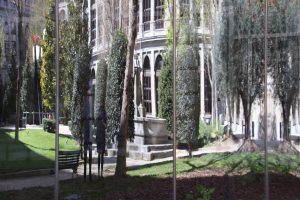The weather today was very good. The overnight low was in the 40s and by late afternoon it had reached the mid 70s. The forecast was for clouds, but there were very few.
For the first time on this trip we did not go out for breakfast! We are close to many places that serve desayuno, but we stocked up with necessities yesterday and were able to have toast, OJ, cheese, and muesli in the apartment. But the big thing for Patricia was that she was able to make café con leche. That’s been a stumbling block to eating in.
Today we made our first visit to the Reina Sofía museum (long name: Museo National Centro de Arte Reina Sofía). It focuses on 20th century art and mostly on Spanish artists. It was opened in 1992. When I bought tickets, I simply asked for “dos” but Patricia was more on the ball and said “seniors?” The attendant asked for documentation and then pushed back my money and said “for you, is free.” Nice discount!
I went with the idea that we would cruise through the entire place in a couple of hours. After all, it was 20th century art, and how could that be interesting? I was wrong, of course. We were there for more than 3 hours and saw most of 1 floor (out of 4) and a special exhibit in 2 rooms on another floor. There were names I recognized, such as Picasso and Dali, but many more that I did not. Much of the art was, for lack of a better term, inaccessible to me. That is, I was often unsure of what I was seeing. Even reading the notes beside the art did not help much.
The section of the museum we started with covered the period after the Spanish Civil War and included some European art after WWII. Part of the 4th floor was entitled “Is the War Over Yet” because it made clear that just because the shooting had stopped, the suffering—and changes—had not. The exhibits did a good job of showing the rapid evolution of art from the late 1930s on into the 1960s.
We watched a film by José Val del Omar called Aguaespejo granadino (Water-Mirror of Granada) which was (I think) about Granada and water. It was intended to be an “audiovisual symphony” and it is difficult to describe. It was made in the early 1950s and is mostly in black and white. Its attraction to us was that if featured many parts of Granada and the Alhambra that we had just seen and the music was that of Manuel de Falla and of the flamenco style of singing called cante jondo (deep song). As far as I could tell, there was no narrative / story to the 20-minute film but it was full of images/music/spoken text that kept us watching.
I think Patricia would agree that the most impactful (if that’s a word) exhibit we saw today was Ceija Stojka’s “This Has Happened” (Esto ha pasado). Stojka was an Austro-Romani artist (1933-2013) who was a member of the Rom (we might say gypsy) community in Austria that the Nazis tried to exterminate. She managed to survive 3 concentration camps and when she was in her 50s undertook to recount her experiences through painting, drawing, and writing. I mentioned that I didn’t understand a lot of the 20th-century art that I saw today, but I am almost sorry to say that this art was all too easy to understand. Stojka was a self-taught artist and some might have criticisms of her style. But the meanings/stories cam through clearly and could not be misunderstood. Some of the art showed life near Vienna, Austria of the Rom family, which had live in the area for a very long time. It painted an idyllic picture. Then, we see the Nazis rounding up the Rom, the crowded train cars, soldiers threatening, no food, and fear, always fear.
In other parts of the the museum I took pictures. In this exhibit, neither Patricia or I felt we could take pictures. Anything we tried would have robbed the artist’s work of its vitality and power.
And now, a complete change of topic…
Tonight we went to see the first of our 5 flamenco performances in Madrid at Teatro Flamenco. It wasn’t a tablao, but more of a stage and when we saw the setting, we wondered if we would see an over-choreographed production with no feeling. What we did see was a very good performance by professional, engaged artists. Every aspect was good. Adrian Santana, Concha Jareño, Carmen la Talegona (bailaores), Manuel de La Niña, Antonio Luque “Canto” (cantaores), and Fran Vinuesa (guitarrista), worked together very well and presented several different styles. [I think we saw Adrian Santana in a performance in Albuquerque.] Patricia and I enjoyed it a lot.
After the show we talked to the manager, Javier, about flamenco in Santa Fe and Albuquerque. He told us that his brother had performed at the flamenco festival in Albuquerque some time ago. We were reminded once again of how small a world it is and how interconnected the flamenco community is.
Tomorrow it is supposed to be even warmer than today. What a contrast to our last visit 2 years ago.





